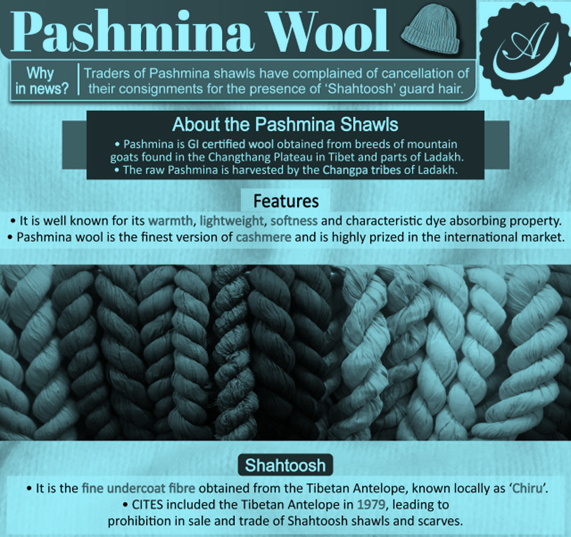Description

Copyright infringement not intended
Context: The Kashmir Chamber of Commerce and Industry (KCCI), a Valley-based merchants' organisation, has highlighted the problem of pashmina shawl seizure and substandard testing with the Union Minister for Forest, Environment, and Climate Change.
Details
- According to the Kashmir Chamber of Commerce and Industry (KCCI), the Customs Department is regularly seizing shawl consignments at the country's international airports.
- They stated that "if the barriers are lifted, exports of Kashmiri shawls will reach somewhere between 1,000 crores and 2,000 crores."
What are the Concerns?
Shahtoosh guard hair
- Airport microscopes easily identify prohibited shahtoosh guard hair (wool from the chiru goat or Tibetan antelope) in pashmina shawls (wool from the pashmina goat).
- Pashmina wool thread width is 13 to 16 microns, while shahtoosh thread width is less than 11 microns (the diameter of human hair is 70 microns).
- According to the Wildlife Trust of India (WTI), Switzerland officials have discovered 537 illicit imports of shahtoosh scarves in the last five years, indicating an ongoing illegal trade.

Delays in testing
- For further investigations, the shawl is sent to laboratories in Dehradun or Kolkata for further testing. Traders wait months to receive the report. Sometimes, the reports are inconclusive.
- Traders are being questioned, and CBI raids on artists involved in the weaving of these pashmina shawls are constantly occurring.
Declining export
- According to official estimates from the Kashmir Handicrafts Department, shawl exports fell from 305 crores in 2018-19, when the Government removed J&K's unique constitutional standing, to 272 crores in 2019-20, 172 crores in 2020-21, and 166 crores in 2021-22.

Keywords
Shahtoosh Ban
- The production of shahtoosh shawls in Kashmir has stopped since the J&K government issued a ban in 2002.
- The move came when the chiru population began to decline in the 1980s.
Wildlife Trust of India (WTI)
- It is an Indian environmental conservation organisation founded in 1969 in response to India's rapidly deteriorating wildlife situation.
- It is a registered charity (under Section 12A of the Income Tax Act, 1961).
- It is currently concentrating its efforts on six key landscapes: northeast India, the western Himalayas, the Terai, the Southern Ghats system, central India, and terrestrial ecosystems.
Must Read Articles:
Pashmina shawls: https://www.iasgyan.in/daily-current-affairs/pashmina-17
|
PRACTICE QUESTION
Q. Consider the following Statement;
1. It refers to a fine variant of spun cashmere, the animal-hair fibre forming the downy undercoat of the Changthangi goat.
2. India accounts for 70% of the world's cashmere production.
3. Kashmiri Pashmina has got the GI tag.
Which of the following Statement is/are correct?
(A) 1 and 2 only
(B) 2 and 3 only
(C) 1 and 3 only
(D) 1, 2 and 3
Answer: C
Explanation:
Statement 1 is correct: Pashmina refers to a fine variant of spun cashmere, the animal-hair fibre forming the downy undercoat of the Changthangi goat.
Statement 2 is incorrect: China accounts for 70% of the world's cashmere production, Mongolia 20%, and the remaining 10% of production is in Afghanistan, Australia, India, Iran, Nepal, Pakistan, and the United States.
Statement 3 is correct: Kashmiri Pashmina has got the GI tag. It has been registered under the Geographical Indications registry of India.
|

https://epaper.thehindu.com/ccidist-ws/th/th_delhi/issues/30911/OPS/GTKB2GR0I.1+GPIB2GVVE.1.html















